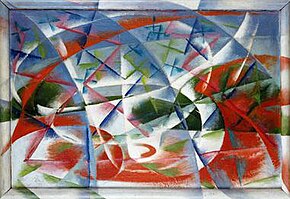Abstract Speed + Sound (Italian: Velocità astratta + rumore) is a painting by Italian Futurist painter Giacomo Balla, one of several studies of motion created by the artist in 1913–14.
| Abstract Speed + Sound | |
|---|---|
| Italian: Velocità astratta + rumore[1] | |
 | |
| Artist | Giacomo Balla |
| Year | 1913–14 |
| Type | oil paint on millboard |
| Subject | abstract |
| Dimensions | 54.5 cm × 76.5 cm (21.5 in × 30.1 in)[1] |
| Location | Peggy Guggenheim Collection, Venice[2] |
| Accession | 76.2553.31 |
Description
editThe painting evokes the sensation of the passing of an automobile, with crisscrossing lines representing sound.[1][3] It may be the second in a triptych narrating the passage of a racing car through a landscape, beginning with Abstract Speed (Velocità + paesaggio) (1913) and ending with Abstract Speed – The Car Has Passed (1913). The three paintings share indications of a single landscape, and each painting is continued onto its frame.[1]
Inspiration
editBalla chose the automobile as a symbol of speed, reflecting the statement of Futurist founder Filippo Tommaso Marinetti's 1909 first manifesto: "The world's splendor has been enriched by a new beauty: the beauty of speed... A roaring automobile...that seems to run on shrapnel, is more beautiful than the Victory of Samothrace."
Legacy
editThe painting is said to have captured the ideals of Italian Futurism.[4] It was featured on the 1980 British television series 100 Great Paintings, which presented five paintings from each of 20 thematic groups.[5]
The Philadelphia Museum of Art houses an apparent study for the painting, a 23.5 cm × 33 cm (9.3 in × 13.0 in) work in watercolor and graphite.[6]
See also
editReferences
edit- ^ a b c d "Giacomo Balla: Abstract Speed + Sound (Velocità astratta + rumore)". Peggy Guggenheim Collection. Retrieved 20 July 2016.
- ^ "Abstract Speed + Sound". WikiArt. Retrieved 20 July 2016.
- ^ Day, Gail (1999). "The Futurists: transcontinental avant-gardism". In Wood, Paul (ed.). The Challenge of the Avant-garde. Yale University Press. pp. 217–218. ISBN 0-300-07761-0.
- ^ Carr, Maureen A. (2014). After the Rite: Stravinsky's Path to Neoclassicism (1914–1925). Oxford University Press. p. 18. ISBN 978-0199742936. Retrieved 20 July 2016.
- ^ "Top 100 Masterpieces". Toperfect. Retrieved 20 July 2016.
- ^ "Velocità astratta + rumore (Abstract Speed + Noise)". Philadelphia Museum of Art. Retrieved 20 July 2016.